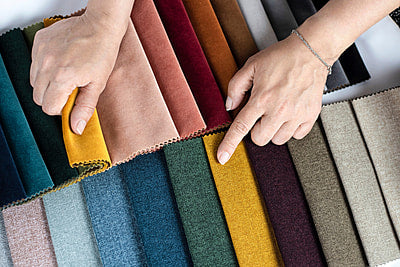How different types of upholstery holds up to wear?
1. Leather: High-quality leather is among the most durable upholstery fabrics and is a good choice for those with a busy lifestyle or children. It remains cool during the summer months, and warm in the winter, offering year-round comfort. Leather is also resistant to spills and stains and improves with age.
2. Microfiber: Microfiber resembles suede and is a cost-effective fabric, making it a popular choice for budget-conscious consumers. It's made from tightly woven synthetic fibers, providing durability and moisture resistance, making it ideal for sharing the couch with kids and pets.
3. Cotton: This natural fabric provides good resistance to wear, fading, and pilling. A blend of cotton with synthetic fibers increases its durability. Cotton can also be dyed to any color, allowing for a wide range of decoration options.
4. Linen: While not as resilient as some other fabrics, linen holds up quite well to daily wear and tear. However, it may not be the best choice for households with children or pets.
5. Vinyl: Vinyl fabric is a less expensive and more durable alternative to leather. It's an ideal choice for furniture in high-traffic areas or children's rooms due to its high durability and ease of maintenance.
6. Wool: This natural upholstery fabric is durable and sturdy. Wool blends, which combine synthetic and natural fibers, are more resistant to pilling, wrinkling, fading, and soil.
7. Nylon: Known for its toughness and durability, nylon can withstand heavy use. It is commonly blended with other fibers to make it one of the strongest upholstery fabrics.
8. Olefin: It is a very durable fabric that has a wool-like feel. It is often used in furniture meant for heavy wear, making it useful for households with kids or pets.
9. Polyester: Used often with other fibers to achieve specific characteristics like resistance to wrinkling, crushing, and fading. It is commonly used in mix with wool and cotton fibers.
10. Velvet: While not as durable as many other fabrics, velvet is a luxury choice for those prioritizing aesthetics over lifestyle considerations. However, it requires regular care and cleaning to maintain its plush look.
Each upholstery fabric has pros and cons, and the final decision should be based on your individual needs and lifestyle. High-traffic areas may need more durable fabrics while furniture pieces not often used could opt for aesthetics over resistance.
2. Microfiber: Microfiber resembles suede and is a cost-effective fabric, making it a popular choice for budget-conscious consumers. It's made from tightly woven synthetic fibers, providing durability and moisture resistance, making it ideal for sharing the couch with kids and pets.
3. Cotton: This natural fabric provides good resistance to wear, fading, and pilling. A blend of cotton with synthetic fibers increases its durability. Cotton can also be dyed to any color, allowing for a wide range of decoration options.
4. Linen: While not as resilient as some other fabrics, linen holds up quite well to daily wear and tear. However, it may not be the best choice for households with children or pets.
5. Vinyl: Vinyl fabric is a less expensive and more durable alternative to leather. It's an ideal choice for furniture in high-traffic areas or children's rooms due to its high durability and ease of maintenance.
6. Wool: This natural upholstery fabric is durable and sturdy. Wool blends, which combine synthetic and natural fibers, are more resistant to pilling, wrinkling, fading, and soil.
7. Nylon: Known for its toughness and durability, nylon can withstand heavy use. It is commonly blended with other fibers to make it one of the strongest upholstery fabrics.
8. Olefin: It is a very durable fabric that has a wool-like feel. It is often used in furniture meant for heavy wear, making it useful for households with kids or pets.
9. Polyester: Used often with other fibers to achieve specific characteristics like resistance to wrinkling, crushing, and fading. It is commonly used in mix with wool and cotton fibers.
10. Velvet: While not as durable as many other fabrics, velvet is a luxury choice for those prioritizing aesthetics over lifestyle considerations. However, it requires regular care and cleaning to maintain its plush look.
Each upholstery fabric has pros and cons, and the final decision should be based on your individual needs and lifestyle. High-traffic areas may need more durable fabrics while furniture pieces not often used could opt for aesthetics over resistance.

